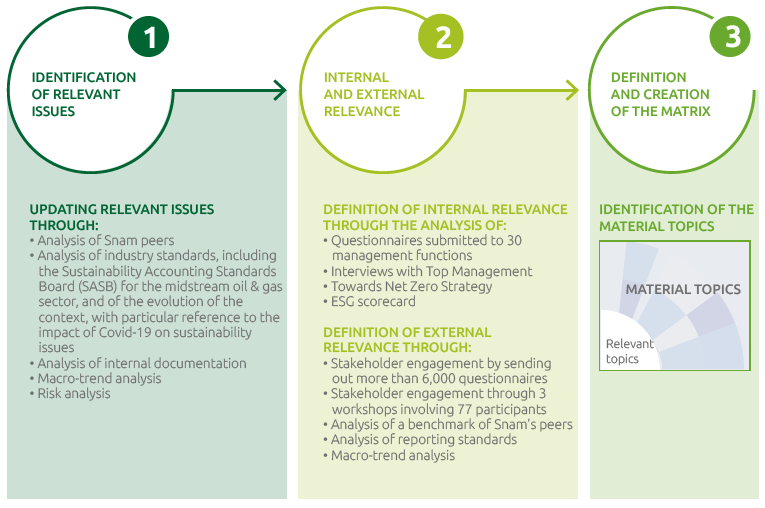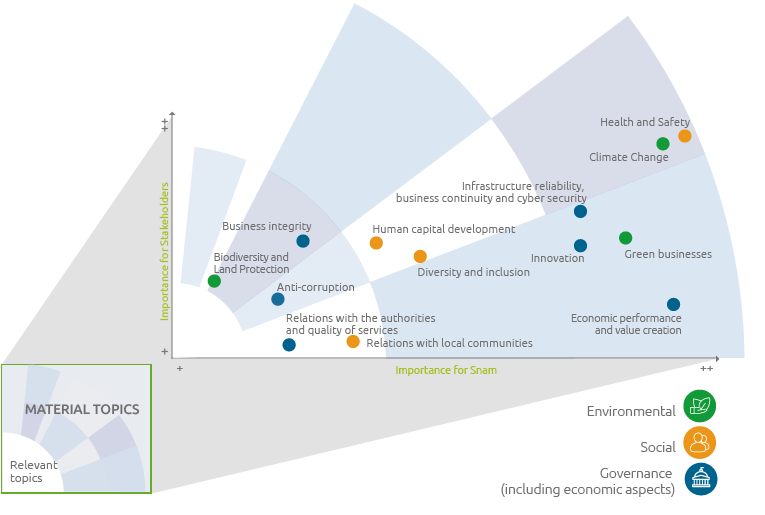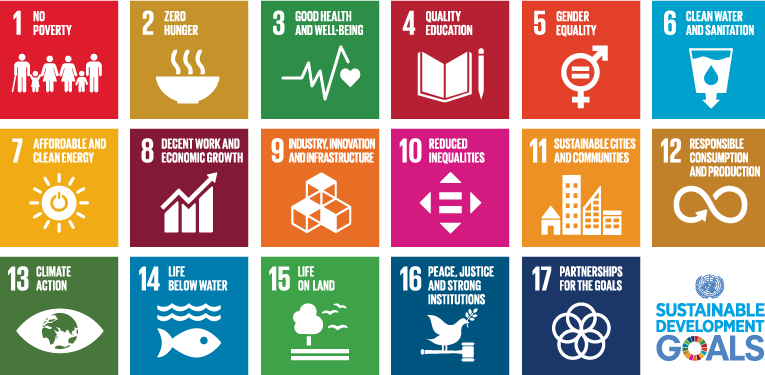The Materiality analysis
Through the stakeholder engagement activities carried out during the year, the Group updated its materiality analysis in order to identify the most relevant sustainability issues (material topics) that significantly reflect the economic, environmental and social impacts of the organisation, or that influence stakeholder decisions.
In the analysis, which is carried out on an annual basis, the areas as provided for in Legislative Decree 254/2016 and the characteristic aspects of the sector in which Snam operates were considered, to the extent necessary to ensure an understanding of the Company’s activities, its performance, its results and the impact it has produced.
The process for updating the material topics included the following activities:

In order to assess the external relevance of the issues, more than 6,000 stakeholders were reached through specific questionnaires (including employees), with an overall response rate of around 32%. In addition, three in-depth materiality workshops were held involving 77 people including suppliers, customers and employees. During these meetings, the 2020-2024 Strategic Plan was illustrated, with particular reference to sustainability issues, and the set of issues to be assessed as part of the materiality analysis was presented. Participants were then able to evaluate these issues in real time through the use of an interactive tool that allowed them to analyse and discuss the results directly during the meeting.
To assess internal relevance, Snam managers were involved in order to have a holistic and shared view of the Company’s priorities. The result of this process led to the identification of material sustainability issues and the definition of the materiality matrix. The materiality matrix was validated by management, the Company’s CEO and presented to the ESG (Environmental, Social, and Governance) Committee and the Board of Directors.
In view of the pandemic event, the issue of health and safety was reconfirmed as a priority for the Group, as was climate change, up from 2019, confirming its commitment to decarbonisation. In addition, the topic of relations with the authorities and quality of services gained a higher ranking and was included in the material issues.
However, unlike in 2019, and although it continues to remain relevant, the issue of brand reputation has not been included among the material issues, thanks to important brand building work carried out in previous years, which has led to a clear consolidation of the Group’s approach to this aspect.
The analyses described above have also made it possible to identify issues which, although not material, are nevertheless relevant to Snam or its stakeholders and which are carefully monitored and controlled: supply chain, waste management, water management, employment, brand reputation, respect for human rights, air protection.

ISSUES |
DEFINITION |
SDGs |
|---|---|---|
Health and Safety |
Adopt practices and management systems to safeguard the health and safety of employees and third parties involved in company activities (e.g. suppliers), also with reference to pandemic events. |
3,8 |
Climate Change |
Promote climate change mitigation strategies, so as to reduce greenhouse gases and environmental impact. Develop energy efficiency initiatives at the Group’s plants and sites, promote more sustainable business conduct through the use and production of energy from renewable sources. |
7,13 |
Infrastructure reliability, business continuity and cyber security |
Ensure the reliability of infrastructures and services in order to prevent and/or mitigate potential situations that could compromise business continuity (e.g. emergencies, pandemic events). Manage cyber security with particular reference to potential cyber attacks, also in the light of the continuous increase in the use of of IT tools (also accelerated by the COVID-19 pandemic). |
9 |
Green businesses |
Integrate in its operations, in support of a low-carbon and circular economy, new businesses that accompany the processes of decarbonisation, such as biomethane, hydrogen, use of gas for sustainable mobility (CNG, LNG) and new technologies capable of incorporating renewable energy from the environment. |
11,13 |
Business Integrity |
Carry out activities with loyalty and fairness in compliance with the law, regulations, prescriptions and supplementary and improving company provisions. Ensure a responsible approach to fiscal strategy and ensure the efficiency of corporate governance, with particular attention to the issues of remuneration and balanced participation in key corporate governance bodies. |
16 |
Human capital development |
Encourage professional growth paths and policies for attracting and retaining talent, and enhancing the technical, managerial and organisational skills of employees. |
8 |
Economic performance and value creation |
Promote the creation of shared medium to long-term value for all categories of stakeholders, through operational and financial efficiency and commit to the development of business activities capable of generating value for all stakeholders. |
8 |
Innovation |
Research new technologies aimed at increasing the efficiency of business and reducing environmental impacts, also with a view to the circular. Exploit technological innovation (e.g. cloud, Al, etc.) for greater efficiency of operations and services offered, to digitise and optimise the monitoring and management of infrastructure and to easily integrate new green business opportunities. |
9 |
Relations with the authorities and quality of services |
Ensure that customers receive a safe and reliable service over time, in compliance with the principles of competition and equal treatment and access to infrastructure and promote constructive and transparent relationships with regulatory authorities and institutions, in order to develop satisfactory services for customers and at the same time oriented to the needs and demands of the market. |
16 |
Diversity and inclusion |
Promote and ensure equal opportunities to all employees, enhance and protect diversity (concerning race, religion, culture, gender, sexual orientation, and age) promoting dialogue and collaboration initiatives to seize the opportunities arising from different experiences, knowledge, skills, and background. |
5,10 |
Relations with local communities |
Engage local communities in order to develop project activities capable of effectively responding to stakeholder expectations and supporting local communities in times of economic uncertainty, also in order to strengthen the license to operate. |
8,11 |
Anti-corruption |
Adopt preventive measures and targeted policies, and promote partnerships aimed at combating corruption and crime in general and at spreading a culture of legality. |
16 |
Biodiversity and Land Protection |
Safeguard the landscape heritage of the territories where the Group’s plants or sites are located and promote environmental protection during both commissioning and ordinary operations, by integrating soil, subsoil and groundwater protection policies into its operational activities. |
14,15 |



